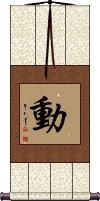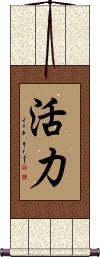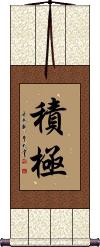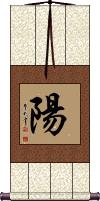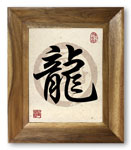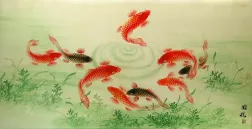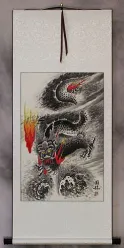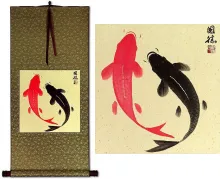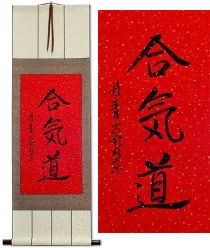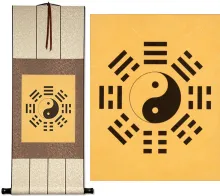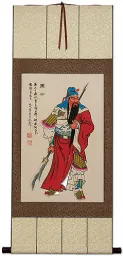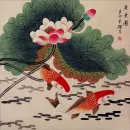Many custom options...
And formats...

Dynamic in Chinese / Japanese...
Buy a Dynamic calligraphy wall scroll here!
Personalize your custom “Dynamic” project by clicking the button next to your favorite “Dynamic” title below...
Dynamic
動態 is the Chinese, Japanese Kanji, and old Korean Hanja for a word that means “dynamic state.”
This word can also mean:
movement; motion; development; trend; dynamic (science); the state of being dynamic.
This word can be used to describe someone or an organization that keeps up with cutting-edge trends. Always flexible, always changing, always moving.
Dynamic
Moving / Motion / Ever-Changing
動 is the only Chinese/Japanese/Korean word that can encompass the idea of “dynamic” into one character.
動 can also mean:
to use; to act; to move; to change; motion; stir.
In the Buddhist context, it means: Movement arises from the nature of wind which is the cause of motion.
The key point of this word is that it represents motion or always moving. Some might say “lively” or certainly the opposite of something that is stagnant or dead.
Note: In Japanese, this can also be a female given name, Yurugi.
Dynamic Energy / Enthusiasm
Dynamic Energy / Enthusiasm
活力 is a Chinese, Japanese, and Korean word that can be defined as energy, vitality, vigor, vital force, enthusiasm, energetic, or dynamism.
Initiative / Proactive / Positive
This word closely matches the way initiative is often used in English. This word can also mean active, energetic, vigorous, positive (outlook), or proactive in Chinese.
The meaning also includes positive and progressive in Japanese and Korean.
Yako / Minami
This can be the Japanese surname Yako or Minami.
陽 is actually the yang from yin and yang ☯.
The meaning includes positive, sun, male, the side on which the sun shines, the sun, heat, masculine, dynamic, etc.
This in-stock artwork might be what you are looking for, and ships right away...
Gallery Price: $196.00
Your Price: $108.88
Gallery Price: $106.00
Your Price: $58.88
Gallery Price: $200.00
Your Price: $79.88
Gallery Price: $108.00
Your Price: $59.88
Gallery Price: $90.00
Your Price: $49.88
Gallery Price: $286.00
Your Price: $158.88
Not the results for dynamic that you were looking for?
Below are some entries from our dictionary that may match your dynamic search...
| Characters If shown, 2nd row is Simp. Chinese |
Pronunciation Romanization |
Simple Dictionary Definition |
陽 阳 see styles |
yáng yang2 yang youji / yoji ようじ |
More info & calligraphy: Yako / Minami(noun - becomes adjective with の) (1) (the) positive; (2) (ant: 陰・2) yang (in Chinese divination); (3) (See 陰に陽に) the open; visible place; public place; (personal name) Yōji The side on which the sun shines, the sun, heat, this life, positive, masculine, dynamic, etc. |
動態 动态 see styles |
dòng tài dong4 tai4 tung t`ai tung tai doutai / dotai どうたい |
More info & calligraphy: Dynamic(See 静態) movement; dynamic state |
ボアズ see styles |
boazu ボアズ |
More info & calligraphy: Boaz |
活力四射 see styles |
huó lì sì shè huo2 li4 si4 she4 huo li ssu she |
More info & calligraphy: Dynamic Energy / Enthusiasm |
動圖 动图 see styles |
dòng tú dong4 tu2 tung t`u tung tu |
(computing) dynamic image |
動圧 see styles |
douatsu / doatsu どうあつ |
{physics} (See 静圧) dynamic pressure |
動感 动感 see styles |
dòng gǎn dong4 gan3 tung kan doukan / dokan どうかん |
sense of movement (often in a static work of art); dynamic; vivid; lifelike (form) (feeling of) movement; liveliness; vividness (e.g. of a painting); life |
動的 see styles |
douteki / doteki どうてき |
(adjectival noun) dynamic; kinetic |
揚力 see styles |
youryoku / yoryoku ようりょく |
dynamic lift; lifting power |
氤氳 氤氲 see styles |
yīn yūn yin1 yun1 yin yün inun いんうん |
(literary) (of smoke, mist) dense; thick (adjective) (rare) energetic; lively; dynamic; vigorous |
法性 see styles |
fǎ xìng fa3 xing4 fa hsing hosshou / hossho ほっしょう |
{Buddh} (See 法相・ほっそう・1) dharmata (dharma nature, the true nature of all manifest phenomena); (personal name) Hosshou dharmatā. Dharma-nature, the nature underlying all thing, the bhūtatathatā, a Mahāyāna philosophical concept unknown in Hīnayāna, v. 眞如 and its various definitions in the 法相, 三論 (or法性), 華嚴, and 天台 Schools. It is discussed both in its absolute and relative senses, or static and dynamic. In the Mahāparinirvāṇa sūtra and various śāstras the term has numerous alternative forms, which may be taken as definitions, i. e. 法定 inherent dharma, or Buddha-nature; 法住 abiding dharma-nature; 法界 dharmakṣetra, realm of dharma; 法身 dharmakāya, embodiment of dharma; 實際 region of reality; 實相 reality; 空性 nature of the Void, i. e. immaterial nature; 佛性 Buddha-nature; 無相 appearance of nothingness, or immateriality; 眞如 bhūtatathatā; 如來藏 tathāgatagarbha; 平等性 universal nature; 離生性 immortal nature; 無我性 impersonal nature; 虛定界: realm of abstraction; 不虛妄性 nature of no illusion; 不變異性 immutable nature; 不思議界 realm beyond thought; 自性淸淨心 mind of absolute purity, or unsulliedness, etc. Of these the terms 眞如, 法性, and 實際 are most used by the Prajñāpāramitā sūtras. |
法界 see styles |
fǎ jiè fa3 jie4 fa chieh hokkai; houkai / hokkai; hokai ほっかい; ほうかい |
(1) {Buddh} universe; (2) {Buddh} realm of thought; (3) {Buddh} underlying principle of reality; manifestation of true thusness; (4) (ほうかい only) (abbreviation) (See 法界悋気) being jealous of things that have nothing to do with one; being jealous of others who are in love with each other dharmadhātu, 法性; 實相; 達磨馱都 Dharma-element, -factor, or-realm. (1) A name for "things" in general, noumenal or phenomenal; for the physical universe, or any portion or phase of it. (2) The unifying underlying spiritual reality regarded as the ground or cause of all things, the absolute from which all proceeds. It is one of the eighteen dhātus. These are categories of three, four, five, and ten dharmadhātus; the first three are combinations of 事 and 理 or active and passive, dynamic and static; the ten are: Buddha-realm, Bodhisattva-realm, pratyekabuddha-realm, śrāvaka, deva, Human, asura, Demon, Animal, and Hades realms-a Huayan category. Tiantai has ten for meditaton, i.e. the realms of the eighteen media of perception (the six organs, six objects, and six sense-data or sensations), of illusion, sickness, karma, māra, samādhi, (false) views, pride, the two lower Vehicles, and the Bodhisattva Vehicle. |
法身 see styles |
fǎ shēn fa3 shen1 fa shen hotsushin ほつしん |
{Buddh} (See 三身) dharmakaya (dharma body, Buddhism's highest form of existence); (surname) Hotsushin dharmakāya, embodiment of Truth and Law, the "spiritual" or true body; essential Buddhahood; the essence of being; the absolute, the norm of the universe; the first of the trikāya, v.三身. The dharmakāya is divided into 總 unity and 別 diversity; as in the noumenal absolute and phenomenal activities, or potential and dynamic; but there are differences of interpretation, e.g. as between the 法相 and 法性 schools. Cf. 法身體性. There are many categories of the dharmakāya. In the 2 group 二法身 are five kinds: (1) 理 "substance" and 智 wisdom or expression; (2) 法性法身 essential nature and 應化法身 manifestation; the other three couples are similar. In the 3 group 三法身 are (1) the manifested Buddha, i.e. Śākyamuni; (2) the power of his teaching, etc.; (3) the absolute or ultimate reality. There are other categories. |
無礙 无碍 see styles |
wú ài wu2 ai4 wu ai muge むげ |
without inconvenience; unimpeded; unhindered; unobstructed; unfettered; unhampered (noun or adjectival noun) free from obstacles apratihata. Unhindered, without obstacle, resistless, without resistance, permeating everywhere, all pervasive, dynamic omnipresence which enters everywhere without hindrance like the light of a candle. |
眞如 see styles |
zhēn rú zhen1 ru2 chen ju shinnyo しんにょ |
(surname) Shinnyo bhūtatathatā, 部多多他多. The眞 is intp. as 眞實 the real, 如 as 如常 thus always or eternally so; i.e. reality as contrasted with 虛妄 unreality, or appearance, and 不變不改 unchanging or immutable as contrasted with form and phenomena. It resembles the ocean in contrast with the waves. It is the eternal, impersonal, unchangeable reality behind all phenomena. bhūta is substance, that which exists; tathatā is suchness, thusness, i.e. such is its nature. The word is fundamental to Mahāyāna philosophy, implying the absolute, the ultimate source and character of all phenomena, it is the All. It is also called 自性淸淨心 self-existent pure Mind; 佛性 Buddha-nature; 法身 dharmakāya; 如來藏 tathāgata-garbha, or Buddha-treasury; 實相 reality; 法界 Dharma-realm; 法性Dharma-nature; 圓成實性 The complete and perfect real nature, or reality. There are categories of 1, 2, 3, 7, 10, and 12 in number: (1) The undifferentiated whole. (2) There are several antithetical classes, e.g. the unconditioned and the conditioned; the 空 void, static, abstract, noumenal, and the 不 空 not-void, dynamic, phenomenal; pure, and affected (or infected); undefiled (or innocent), i.e. that of Buddhas, defiled, that of all beings; in bonds and free; inexpressible, and expressible in words. (3) 無相 Formless; 無生 uncreated; 無性 without nature, i.e. without characteristics or qualities, absolute in itself. Also, as relative, i.e. good, bad, and indeterminate. (7, 10, 12) The 7 are given in the 唯識論 8; the 10 are in two classes, one of the 別教 cf. 唯識論 8; the other of the 圓教, cf. 菩提心義 4; the 12 are given in the Nirvana Sutra. |
空法 see styles |
kōng fǎ kong1 fa3 k`ung fa kung fa kūhō |
(1) To regard everything as unreal, i.e. the ego, things, the dynamic, the static. (2) The nirvana of Hīnayāna. |
群像 see styles |
gunzou / gunzo ぐんぞう |
(1) (See 青春群像) lively group (esp. of young people); dynamic bunch; (2) {art} group |
DLL see styles |
dii eru eru; diierueru(sk) / di eru eru; dierueru(sk) ディー・エル・エル; ディーエルエル(sk) |
{comp} dynamic link library; DLL |
Variations: |
pii / pi ピー |
(1) P; p; (2) (P only) (abbreviation) (See プロデューサー) producer; (3) (P only) parking; (4) (P only) (abbreviation) {baseb} (See ピッチャー・1) pitcher; (5) (P only) {chem} phosphorus (element symbol); (6) (p only) (abbreviation) {music} (See ピアノ・2) piano (dynamic); (7) (p only) (abbreviation) (See ページ・1) page (number) |
力動的 see styles |
rikidouteki / rikidoteki りきどうてき |
(adjectival noun) dynamic |
力関係 see styles |
chikarakankei / chikarakanke ちからかんけい |
balance of power (in a relationship); power dynamic |
動ばね see styles |
doubane / dobane どうばね |
(See 静ばね) dynamic stiffness; dynamic spring rate |
動安定 see styles |
douantei / doante どうあんてい |
dynamic stability |
動平衡 动平衡 see styles |
dòng píng héng dong4 ping2 heng2 tung p`ing heng tung ping heng |
dynamic equilibrium; dynamic balancing |
動特性 see styles |
doutokusei / dotokuse どうとくせい |
(See 静特性) dynamic characteristics |
法性土 see styles |
fǎ xìng tǔ fa3 xing4 tu3 fa hsing t`u fa hsing tu hōsshō do |
The kṣetra or region of the dharma-nature, i. e. the bhūtatathatā, or 眞如, in its dynamic relations. |
活動的 see styles |
katsudouteki / katsudoteki かつどうてき |
(adjectival noun) active; dynamic; energetic |
爆發力 爆发力 see styles |
bào fā lì bao4 fa1 li4 pao fa li |
explosive power (in athletics, music, dance etc); dynamic intensity |
粘性率 see styles |
nenseiritsu / nenseritsu ねんせいりつ |
viscosity (coefficient); dynamic viscosity (coefficient) |
胎藏界 see styles |
tāi zàng jiè tai1 zang4 jie4 t`ai tsang chieh tai tsang chieh taizō kai |
Garbhadhātu, or Garbhakośa-(dhātu), the womb treasury, the universal source from which all things are produced; the matrix; the embryo; likened to a womb in which all of a child is conceived— its body, mind, etc. It is container and content; it covers and nourishes; and is the source of all supply. It represents the 理性 fundamental nature, both material elements and pure bodhi, or wisdom in essence or purity; 理 being the garbhadhātu as fundamental wisdom, and 智 acquired wisdom or knowledge, the vajradhātu. It also represents the human heart in its innocence or pristine purity, which is considered as the source of all Buddha-pity and moral knowledge. And it indicates that from the central being in the maṇḍala, viz. the Sun as symbol of Vairocana, there issue all the other manifestations of wisdom and power, Buddhas, bodhisattvas, demons, etc. It is 本覺 original intellect, or the static intellectuality, in contrast with 始覺 intellection, the initial or dynamic intellectuality represented in the vajradhātu; hence it is the 因 cause and vajradhātu the 果 effect; though as both are a unity, the reverse may be the rule, the effect being also the cause; it is also likened to 利他 enriching others, as vajradhātu is to 自利 enriching self. Kōbō Daishi, founder of the Yoga or Shingon 眞言 School in Japan, adopted the representation of the ideas in maṇḍalas, or diagrams, as the best way of revealing the mystic doctrine to the ignorant. The garbhadhātu is the womb or treasury of all things, the universe; the 理 fundamental principle, the source; its symbols are a triangle on its base, and an open lotus as representing the sun and Vairocana. In Japan this maṇḍala is placed on the east, typifying the rising sun as source, or 理. The vajradhātu is placed west and represents 智 wisdom or knowledge as derived from 理 the underlying principle, but the two are essential one to the other, neither existing apart. The material and spiritual; wisdom-source and intelligence; essence and substance; and similar complementary ideas are thus portrayed; the garbhadhātu may be generally considered as the static and the vajradhātu as the dynamic categories, which are nevertheless a unity. The garbhadhātu is divided into 三部 three sections representing samādhi or quiescence, wisdom-store, and pity-store, or thought, knowledge, pity; one is called the Buddha-section, the others the Vajra and Lotus sections respectively; the three also typify vimokṣa, prajñā, and dharmakāya, or freedom, understanding, and spirituality. There are three heads of these sections, i. e. Vairocana, Vajrapāṇi, and Avalokiteśvara; each has a mother or source, e. g. Vairocana from Buddha's-eye; and each has a 明王 or emanation of protection against evil; also a śakti or female energy; a germ-letter, etc. The diagram of five Buddhas contains also four bodhisattvas, making nine in all, and there are altogether thirteen 大院 or great courts of various types of ideas, of varying numbers, generally spoken of as 414. Cf. 金剛界; 大日; 兩部. |
Click here for more dynamic results from our dictionary
The following table may be helpful for those studying Chinese or Japanese...
| Title | Characters | Romaji (Romanized Japanese) | Various forms of Romanized Chinese | |
| Dynamic | 動態 动态 | dou tai / doutai / do tai | dòng tài / dong4 tai4 / dong tai / dongtai | tung t`ai / tungtai / tung tai |
| Dynamic | 動 动 | dou / do | dòng / dong4 / dong | tung |
| Dynamic Energy Enthusiasm | 活力四射 | huó lì sì shè huo2 li4 si4 she4 huo li si she huolisishe | huo li ssu she huolissushe |
|
| Dynamic Energy Enthusiasm | 活力 | katsuryoku | huó lì / huo2 li4 / huo li / huoli | |
| Initiative Proactive Positive | 積極 积极 | sekkyoku / sekyoku | jī jí / ji1 ji2 / ji ji / jiji | chi chi / chichi |
| Yako Minami | 陽 阳 | you / yo | yáng / yang2 / yang | |
| In some entries above you will see that characters have different versions above and below a line. In these cases, the characters above the line are Traditional Chinese, while the ones below are Simplified Chinese. | ||||
Successful Chinese Character and Japanese Kanji calligraphy searches within the last few hours...

